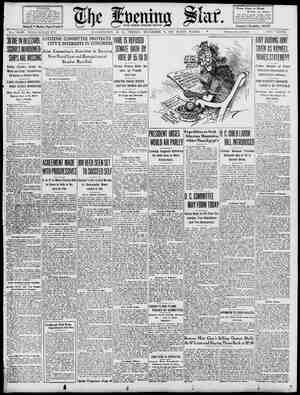Evening Star Newspaper, December 9, 1927, Page 48
You have reached the hourly page view limit. Unlock higher limit to our entire archive!
Subscribers enjoy higher page view limit, downloads, and exclusive features.
e ——————————— e —————————————————— THE EVENING STAR, WASHINGTON, D. €., FRIDAY, DECEMBER 9. 1927 ACT NOW ~ TOO OFTEN has it been TOO LAT At New Orleans the Mississippi river floods last longer, reach great- er volume, and threaten more property than in any other section of the valley. From the point where Red river enters the Mississippi, down to the Gulf of Mexico, a dis- tance of three hundred miles, not a drop of water enters the Mississ- ippi river from the sur- rounding country. South Louisiana and New Or- leans contribute nothing to the flood, yet they must sus- tain the whole crushing bur- den. ' , New Orleans’ first levee was built two centuries ago. It was four feet high, and am- ple to protect the city from overflow. Today the levees from Red river to the Gulf tower above the roofs of homes and fac- tories along both banks of the river, yet they have proved inadequate for a quar- ter of a century to contain the man-made floods that are poured down between them from the North, East and West. Nature never intended these floods to be contained in one channel at the lower end of the river; and man’s presumption in attempting to confine the waters has been rebuked in every preat flood, with excess waters bursting through the levee lines at one or more points, to escape to the sea by a shorter route. Man-made floods from the far reaches of the Mississippi Valley have here resulted in a man-made crevasse below New Orleans to allow the escape of surplus water, and lower the flood level in front of the ci‘f’. The blast that cut the levee line is pictured at the upper left, and the torrent is shown at the right as it rushed destructively through the gap. At the lower left is a bit of flooded countryside, When the carrying capacity of the lower river was exceeded in the 1912 flood, the waters burst through the levee line at Hymelia and at Torras, above New Orleans, ecarrying destruction to the.sugar belt. When the 1922 flood brought a burden too great for the levees to sustain, the river breached the line at Poydras, below New Orleans. In both cases the strain on New Orleans’ flood defense was immed- iately eased, and confidence re- stored amon3 its 450,000 residents. No one could fail to heed the les- sons written by the river itself, and in 1927, when once more the tor- rent had filled the space between the levees, and an additional three-~ foot rise was on its way, South Louisiana did not wait for the river to pick a spot for a crevasse at its own whim. Thelevee line at Caernarvon, below New Orleans, was dynamited with the approval of overnment engineers, and the flood menace blown away over- night. New Orleans is tired of destruc- tive and uncertain crevasses as its means of relief from excessive floods. It has for many years been . demanding controlled spillways, built at suitable locations, where the excess water can be let out of the river, and conducted to the Gulf in a harmless and orderly fashion. South Louisiana engineers are united in the opinion that spillways are practicable and effective. Gov- ernment endineers, after a careful survey under Congressional author- ity, have reached the same conclus sion. The South’s greatest city, ates way to the Mississippi valley and second port of the nation, is entitled to protection. The practicability of immediate and lasting relief for the lower river has already been determined by a careful engineering study by the government’s own engineers, dact- ing directly under a Congressional mandate. It only remains for Congress to act. This Is the Fifth of a Series of Advere tisements Published in the Interest of the People of the Mississippi Valley by The Timeg-Pice W New Orleans [y




